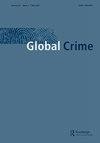The spatial diffusion of homicide in Mexico City: a test of theories in context
IF 1.9
Q2 CRIMINOLOGY & PENOLOGY
引用次数: 10
Abstract
ABSTRACT Homicidal violence has increased substantially in Mexico City in recent years. In this regard, we ask three questions: First, is there a contagious spread of this violence across neighbourhoods? Second, does it spread in association with drug market activity among local criminal organisations? Third, does it spread to neighbourhoods characterised by concentrated disadvantage, disorder, and crime opportunity? Using homicide data aggregated at the neighbourhood level, we found the contagious spread of homicidal violence in neighbourhoods already troubled with drug dealing crimes and concentrated disadvantage. Based on our findings, we propose that while some theories are able to explain the spatial clustering of homicide, only social disorganisation theory is capable of predicting its spatial diffusion. Furthermore, we argue that advances in criminological theory require the testing of ad-hoc correlates when studying the Latin American context.墨西哥城凶杀案的空间扩散:语境中的理论检验
摘要近年来,墨西哥城的凶杀暴力事件大幅增加。在这方面,我们要问三个问题:第一,这种暴力是否会在社区间传播?其次,它是否与当地犯罪组织的毒品市场活动有关?第三,它是否蔓延到以集中劣势、混乱和犯罪机会为特征的社区?利用社区层面的凶杀数据,我们发现,在已经受到毒品交易犯罪和集中劣势困扰的社区,凶杀暴力具有传染性。基于我们的发现,我们提出,虽然一些理论能够解释凶杀的空间聚集性,但只有社会无序理论能够预测其空间扩散。此外,我们认为,犯罪学理论的进步需要在研究拉丁美洲背景时测试特定的相关性。
本文章由计算机程序翻译,如有差异,请以英文原文为准。
求助全文
约1分钟内获得全文
求助全文
来源期刊

Global Crime
CRIMINOLOGY & PENOLOGY-
CiteScore
3.90
自引率
4.50%
发文量
22
期刊介绍:
Global Crime is a social science journal devoted to the study of crime broadly conceived. Its focus is deliberately broad and multi-disciplinary and its first aim is to make the best scholarship on crime available to specialists and non-specialists alike. It endorses no particular orthodoxy and draws on authors from a variety of disciplines, including history, sociology, criminology, economics, political science, anthropology and area studies. The editors welcome contributions on any topic relating to crime, including organized criminality, its history, activities, relations with the state, its penetration of the economy and its perception in popular culture.
 求助内容:
求助内容: 应助结果提醒方式:
应助结果提醒方式:


